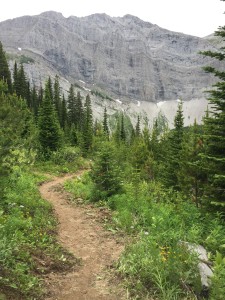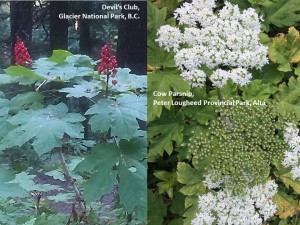By Jenny L. Feick, PhD
Every spring, I take great delight in getting reacquainted with my friends in the plant world. This year, especially, with the social distancing required to help slow the spread of the novel coronavirus, I’ve had to resort to hugging trees instead of embracing my family, friends, and colleagues. This spring in the vicinity of my home on Vancouver Island, I appreciated witnessing the emergence of each wildflower species. Enjoying the display of alpine wildflowers in the Rockies along the GDT provides a source of joy and inspiration that I look forward to each year. I sincerely hope that 2020 will be no exception despite the COVID-19 pandemic.
Plants are important not just for their beauty, or their values as food or medicine. Plants provide clues to the environment that can inform trail route selection. Everyone involved in trail work can benefit from learning to recognize certain plants and the stories they tell about soil, drainage and slope conditions. Knowing the difference between which plants grow in certain conditions can make the difference between choosing a route that will create erosion or other issues with perpetual frustration for GDTA volunteers and hikers or one that poses minimal maintenance requirements and provides an enjoyable hiking experience.
Some plant species prefer well drained soil. Others grow best in wet, poorly drained areas. Certain plants amazingly eke out a living in the most rugged, inhospitable conditions along high windy alpine ridges. Certain plants are resilient to human disturbance and can withstand trampling. Others are heartbreakingly fragile. Several seem to grow back with more vigour the more they are pruned! Some species are abundant; others rare or endangered and even protected by law, with prohibitions against damage or destruction.
While building trail, it is easy to view all plants as obstacles, something to clear away. Instead, listen to what the plants can tell you and you will gain practical knowledge that will make your trail building efforts more effective and enjoyable. Here are a few examples to help get you started.
Needles in Five; Keep them Alive!
Be sure you know how to distinguish a whitebark pine (Pinus albicaulis) from a lodgepole pine (Pinus contortus var. latifolia) when you are out on the GDT. As of 2012, the federal Species at Risk Act lists whitebark pine as Endangered on Schedule 1. Cutting or damaging a whitebark pine is illegal and could jeopardize the GDTA’s ability to continue to build the GDT.
Whereas whitebark pines are relatively rare and easy to route trail around, lodgepole pines are extremely common and many of them need to be cut to build and maintain trail. So, how do you tell the difference? The sure-fire way is to check the bundles of needles emerging from a twig or branch. Whitebark pines have needles in groups of five, whereas lodgepole pines have needles in groups of two. Usually, you find whitebark pine along high subalpine south and west facing ridgetops, in well-drained to dry sites with poorly developed soils or rocky talus, in other words, ideal places to locate the GDT. Lodgepole pine tend to grow at lower elevations, but sometimes they survive on the same rocky ridges where whitebark pine thrive.
The long-lived but slow-growing whitebark pine rely on Clark’s nutcrackers for seed dispersal. In turn, their “pine nuts”, which are more calorie-rich than chocolate and have a higher fat content than butter, help feed those birds, as well as other animals. White Pine Blister Rust, an Asian species introduced via European imports in the 1900s threatens all North American five-needle pine species. Climate change, mountain pine beetle, fire and fire suppression interact to compound or accelerate adverse effects. Let’s do whatever we can to identify and maintain these attractive denizens of high places.
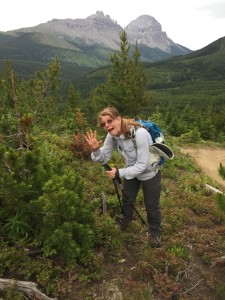
GDTA volunteer Margaret Dumigan points out that this conifer has needles in groups of five and this is thus a protected whitebark pine.
Willow Thou Go, the GDT Shan’t Go
Shrubby vegetation along the GDT often poses the greatest challenge for trail builders. The tendency is to call everything a willow (salix sp.) or an alder (alnus sp.). While both exist along the GDT, many other shrub species do as well, including white-flowered rhododendron (rhododendron albiflorum), false azalea (menzisia), grouseberry (Vacciniumscoparium), buffaloberry (Shepherdia Canadensis), bearberry (arctostapahlous uva-ursi) and juniper (juniperus sp.). Why does it matter? Knowing if a shrub really is a true willow is extremely important, especially species that need wet soils like the diamond leaf willow (Salix planifolia). When routing the GDT, do whatever you can to avoid low-lying areas containing these willows, which quickly become muddy quagmires. Go upslope where the shrubs preferring drier, more well-drained conditions live.
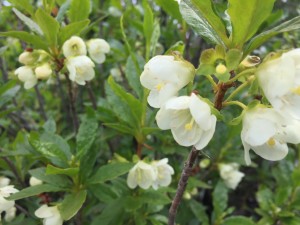
Better to build the GDT along slopes where white-flowered rhododendrons grow, than where willows thrive.
Admire their Beauty from Afar
Several species of attractive and sometimes fragrant wildflowers prefer very moist subalpine or alpine habitats, including fragrant white-rein orchid (Platanthera dilatata), northern grass-of-Parnassus (Parnassia palustris), and pink monkeyflower (Mimulus lewisii). These forbs are often accompanied by sedges, horsetails, and ferns. While you want to provide opportunities for hikers to enjoy seeing wildflowers, please stay out of wet alpine meadows containing these indicator species. Generations of future trail volunteers and thru-hikers will thank you.
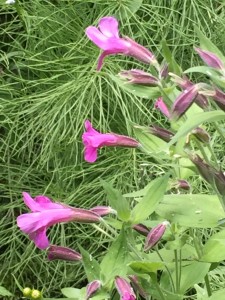
Pink monkey-flowers grow in wet to moist streambanks, seepage areas, meadows and avalanche tracks in the montane to lower alpine zones.
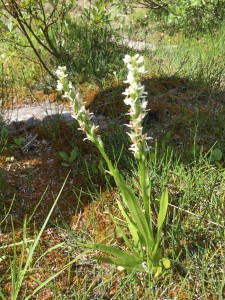
The fragrant white-rein orchid indicates a wet to very wet open site where water collects, aka a wetland where no trail should be built.
Jenny Feick took all of the above pictures during GDTA work parties in 2018 or 2019.
A Little Bit of Knowledge can be a Dangerous Thing
When assessing the plants in an area for the clues they can provide for trail routing and maintenance, check reliable guides to Rocky Mountain flora and seek advice from someone with botanical knowledge. Not all willows prefer wet areas. Vegetation differs depending on whether you are on the drier Eastern Slopes of Alberta or in the moister valleys on the B.C. side of the Great Divide. One volunteer inadvertently cut down a big patch of cow parsnip (Heracleum lanatum) in a meadow along the High Rock section of the GDT, thinking that it was devil’s club (Oplopanax horridus), a spiny understory shrub that grows in wet areas along with old-growth Western red cedar and Western hemlock.
Considering that bears (both grizzly and black) seek cow parsnip as a favourite food source, it may make sense to route the GDT away from extensive patches of this tall herbaceous plant. Many park agencies and communities in bear country like Canmore, Alta. now choose to locate hiking trails away from places containing high concentrations of prized bear food plants to promote peaceful co-existence between bears and people.
Although the leaves look somewhat similar, the spiny shrub devil’s club grows in wet areas shaded by old-growth cedar-hemlock forests whereas the herbaceous perennial cow parsnip thrives on avalanche slopes and other open or partly shaded areas. (Photos by Jenny Feick)

